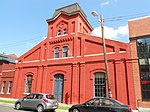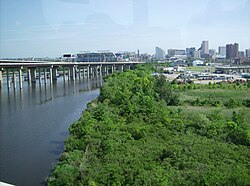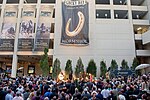Wheelabrator Incinerator
1985 establishments in MarylandBuildings and structures in BaltimoreEnergy infrastructure completed in 1985Towers completed in 1985Towers in Maryland ... and 2 more
Waste power stations in the United StatesWestport, Baltimore

Wheelabrator Baltimore is a waste-to-energy incinerator located in the Westport neighborhood of Baltimore, Maryland and is operated by Wheelabrator Technologies, a subsidiary of Energy Capital Partners. It has an electric generation capacity of 64.5 megawatts. On October 2, 2018, ECP announced the agreement to sell Wheelabrator Technologies to Macquarie Infrastructure Partners, a subsidiary of Macquarie Group.
Excerpt from the Wikipedia article Wheelabrator Incinerator (License: CC BY-SA 3.0, Authors, Images).Wheelabrator Incinerator
Middle Branch Trail, Baltimore
Geographical coordinates (GPS) Address Nearby Places Show on map
Geographical coordinates (GPS)
| Latitude | Longitude |
|---|---|
| N 39.269958333333 ° | E -76.630394444444 ° |
Address
Wheelabrator Incinerator
Middle Branch Trail
21230 Baltimore
Maryland, United States
Open on Google Maps









